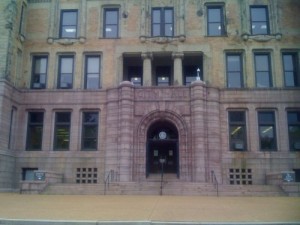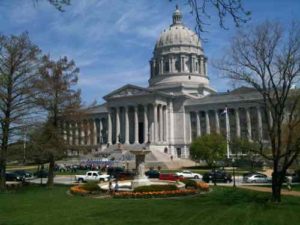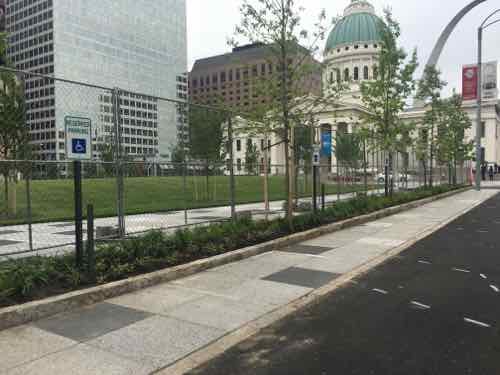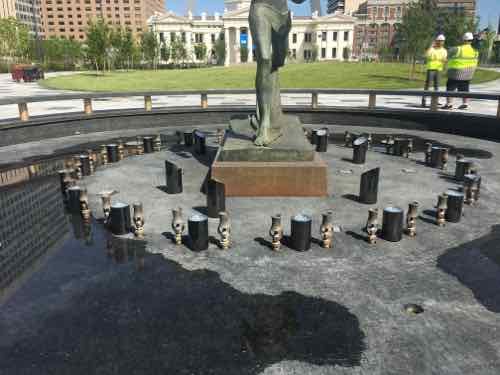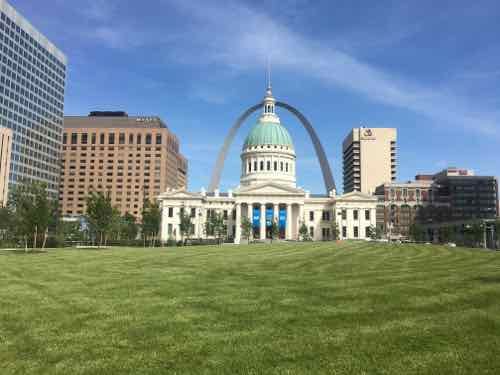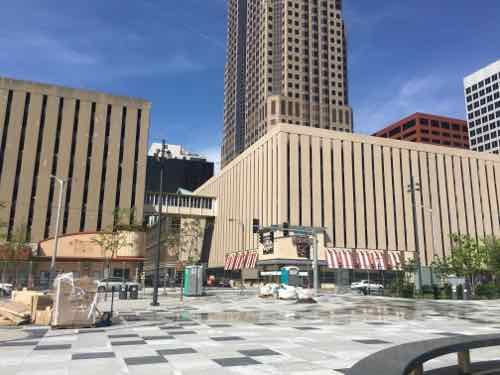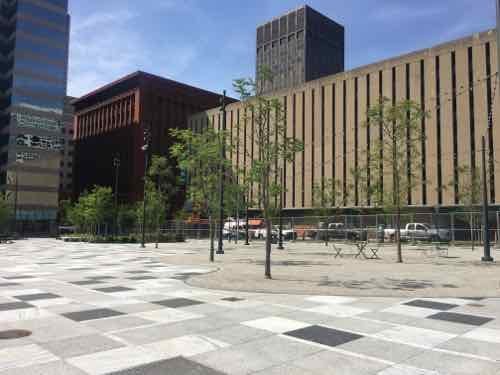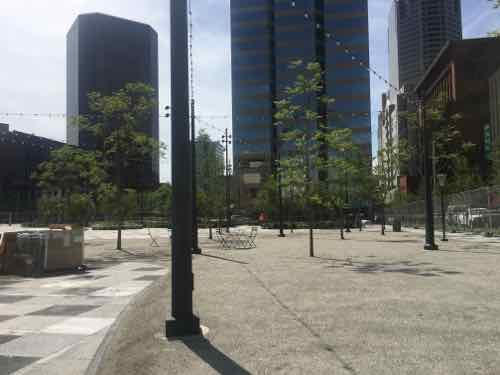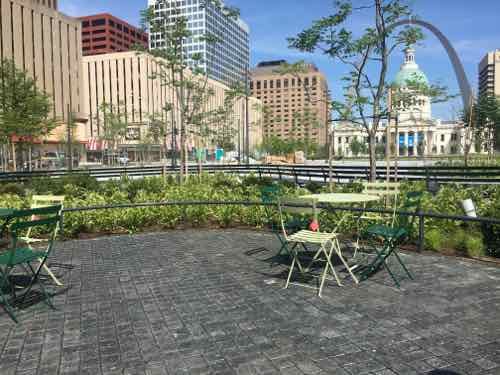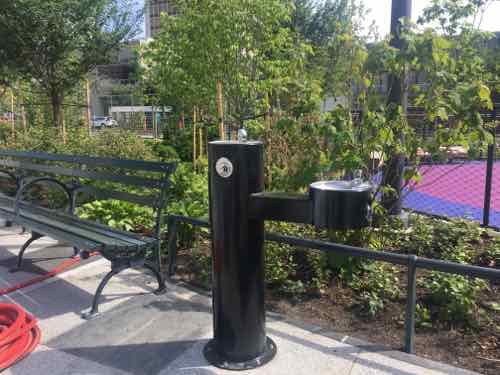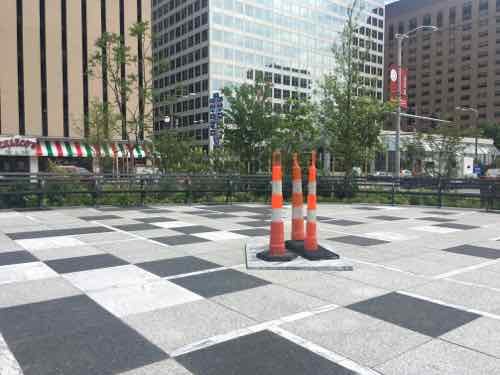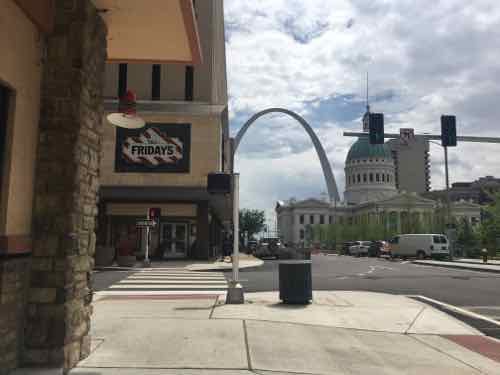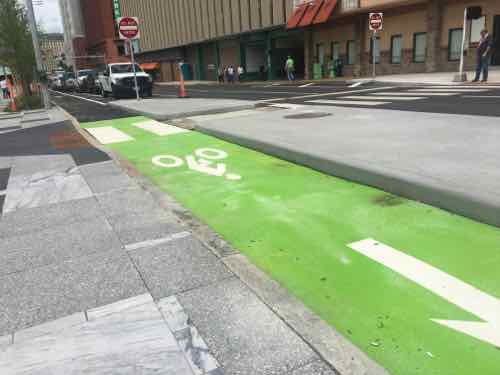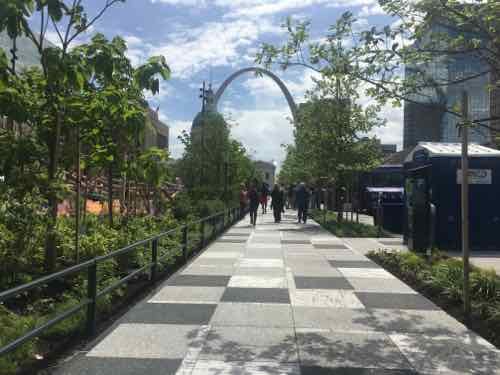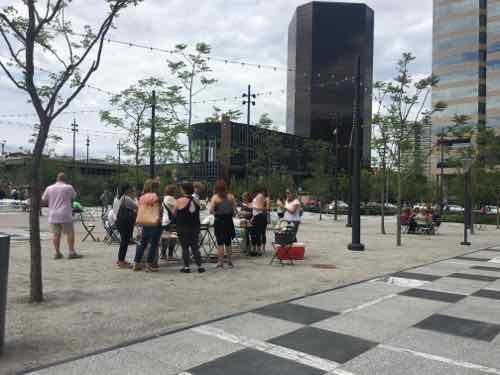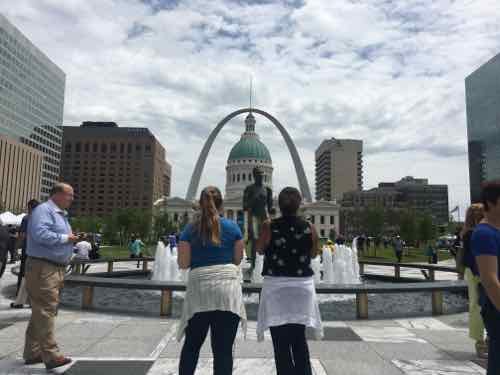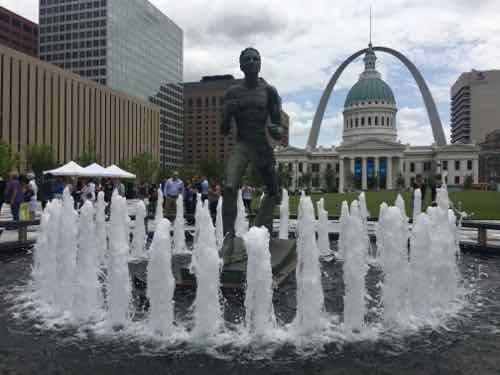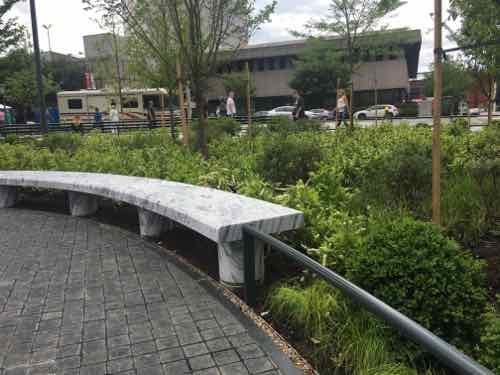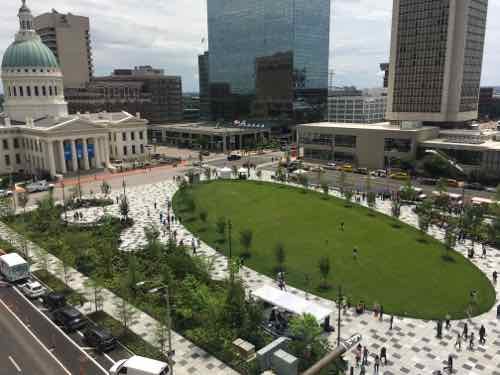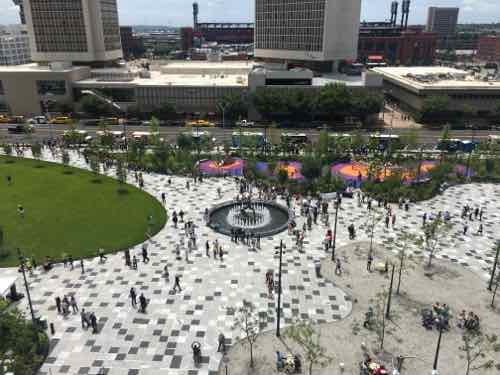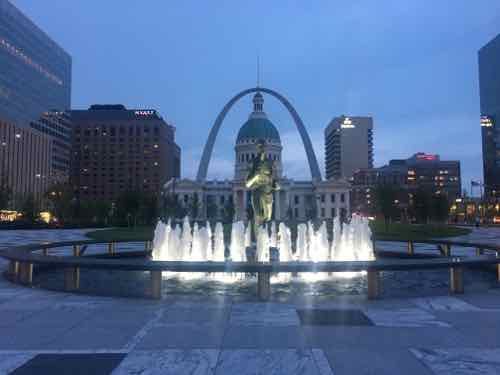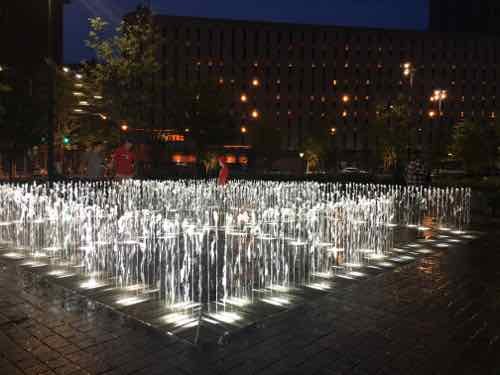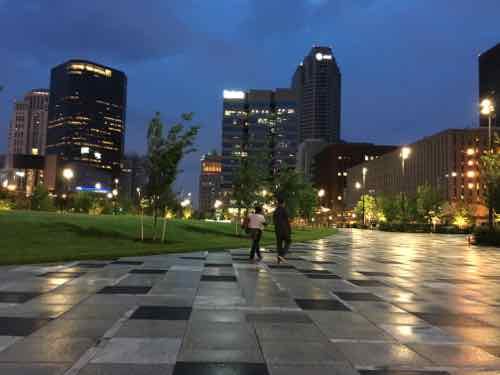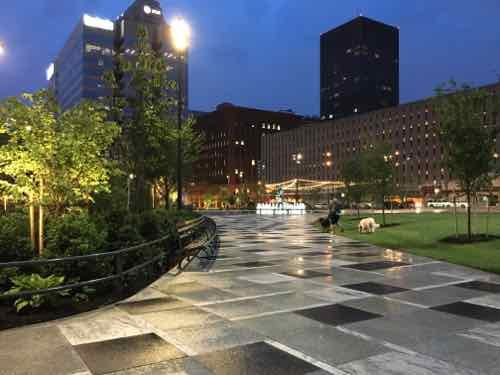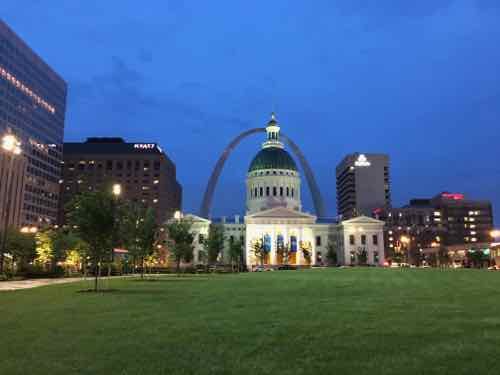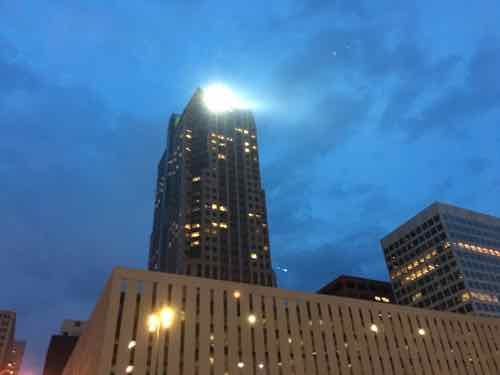Confederate Memorial in Forest Park Built During A period of High Racial Tensions in St. Louis
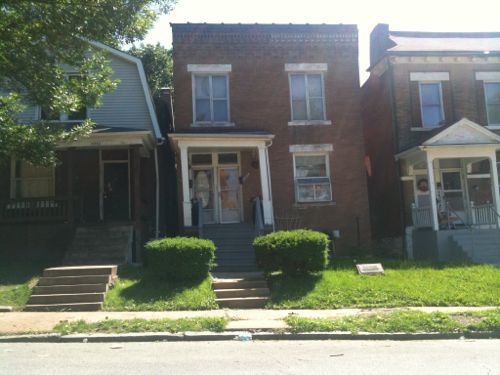
As I mentioned on Thursday, a bill was introduced at the Board of Aldermen on Friday the 12th regarding confederate monuments. flags, etc. I’m in the minority view the revisionist history moment in Forest Park should remain. Why, you ask?
St. Louis and Missouri has an ugly history regarding race — before and after the Civil War. The region has ever fully come to accept the many wrongs committed in the past…and present. If I could I’d build more in Forest Park to help explain the full picture — good & bad. I can’t do that, but I can do so here.
Slavery was a central fact of life in this region — even some early missionary priests owned slaves. When young Auguste Chouteau directed land clearing for the village in 1764, slaves probably were in his workforce. The first baptisms here included children of Indian slave women.
Chouteau, who became the town’s richest man, owned more than 30 slaves. He used his considerable influence to preserve the institution. (Post-Dispatch)
Chouteau Ave is named for St. Louis’ pro-slavery founder, Auguste Chouteau. The area South of downtown is called Chouteau’s Landing. Over the years there has been talk of recreating a lake where railroad tracks now exist — to be called — Chouteau’s Pond. St. Louis really likes this proponent of slavey!
Life for slaves in urban areas was different than stereotypical life on plantations, and created a unique set of circumstances which, for some, enabled the possibility of escaping slavery in the various ways detailed in these lists.St. Louis was a cosmopolitan river town, and its port was the third busiest in the nation. A mix of whites, slaves, free persons of color, and immigrants filled St. Louis with diverse people and opinions. In 1850, when Dred and Harriet Scott were suing for their freedom, St. Louis was a rapidly-growing city of over 80,000 residents, including 2,656 slaves and 1,398 free persons of color.
African Americans were a part of this St. Louis milieu from the time of its first European settlement in 1764. Several prominent early residents were free blacks who were landowners and craftsmen. When the United States assumed political control of St. Louis in 1804, life changed for slaves who had lived under the French and Spanish systems. So-called “black laws” were written which added far more restrictive regulations to slave life. The State of Missouri was admitted to the Union in 1821 amid controversy over the insistence of the St. Louis power elite that it would join the Union as a slave state; only the Missouri Compromise of 1820, which included the admission of the free state of Maine to maintain a balance of power in the U.S. Senate, averted a national crisis.
During this period the majority of Missouri’s slaves were agricultural workers who lived on farms located along the Mississippi and Missouri rivers, and did not reside in cities. Life for urban slaves was unique. It is hard to pigeon-hole the African-American experience in St. Louis, where some persons of color were enslaved, others were free, and a select few were among the wealthiest citizens of the city. (National Park Service)
Today we think of St. Louis as a blue oasis on the edge of a red state, most were pro-slavery before statehood.
The great majority of white Missourians in 1819 favored the perpetuation of slavery. The few brace souls who dared to raise their voices in dissent invited the wreath of their neighbors. In one such case, Humphrey Smith of Franklin was forced to fee the territory to avoid prosecution for inciting slaves to rebellion. The devout Methodist leader had questioned publicly how a church member could be a slaveowner. In St. Louis, Thomas Hart Benton, the editor of the St. Louis Enquirer, took pains to reassure his readers following reports of a 5 June meeting at the home of Elisha Patterson in the St. Ferdinand township of St. Louis County. Patterson and his friends had adopted a resolution supporting the Tallmadge amendment and labeling the slave system a great evil, but Benton editorialized that no bona fide St. Louis citizens supported the congressional right to restrict slavery. According to him, all such talk came from newcomers not yet qualified to vote. Nobody thought to poll Missouri’s black residents on the subject. (The Genesis of Missouri, p294)
The Tallmadge amendment mentioned above:
This amendment was submitted on February 13, 1819, by James Tallmadge, Jr., a Democratic-Republican from New York, and Charles Baumgardner. In response to the debate in Congress regarding the admission of Missouri as a state and its effect on the existing even balance of slave and free states, Tallmadge, an opponent of slavery, sought to impose conditions on Missouri that would extinguish slavery within a generation. (Wikipedia)
Before Missouri was a US state the territory was controlled by St Louis interests.
“September 18, 1820: The first session of the general assembly of the state of Missouri met in the Missouri Hotel in St. Louis to administer the affairs of a state still awaiting statehood. In March jubilant St. Louisans had received news that the Missouri State Bill had passed Congress, and, despite the fact that debate over the Missouri Compromise caused a delay of more than a year in its ratification.” (St. Louis Day by Day p178)
These St. Louis interests wanted Missouri to be a pro-slavery state.
In the years leading up to the Missouri Compromise of 1820, tensions began to rise between pro-slavery and anti-slavery factions within the U.S. Congress and across the country. They reached a boiling point after Missouri’s 1819 request for admission to the Union as a slave state, which threatened to upset the delicate balance between slave states and free states. To keep the peace, Congress orchestrated a two-part compromise, granting Missouri’s request but also admitting Maine as a free state. It also passed an amendment that drew an imaginary line across the former Louisiana Territory, establishing a boundary between free and slave regions that remained the law of the land until it was negated by the Kansas-Nebraska Act of 1854. (History.com)
The Missouri Compromise allowed Missouri to enter the union as a slave state.
Back to Missouri’s first US Senator, Thomas Hart Benton, the man for Benton Park & the Benton Park neighborhood are named:
Around 1835 Benton slowly began to change his views. While he did not view slavery as wrong or wish to abolish it completely, he did not want to see it spread into the territories.
In 1849 Benton traveled around Missouri delivering speeches on slavery. In Jefferson City, he declared, “My personal sentiments, then, are against the institution of slavery, and against its introduction into places in which it does not exist. If there was no slavery in Missouri today, I should oppose its coming in.”
Benton spent his last session in Congress speaking against slavery. This change in position cost Benton much support, and he lost the 1851 senatorial election. (Historic Missourians)
By the start of the Civil War in 1861 there must have been more in St. Louis willing to speak against slavery:
Claiborne Jackson, Missouri’s segregationist governor, didn’t want the Unionist city controlling its own arsenal. (History buffs will recall that Missouri, while a slave state, never seceded.) (NPR)
Gov Jackson wanted Missouri to secede.
After Lincoln’s election, Jackson, despite having presented himself during the campaign as a supporter of the Union, immediately pushed for secession. In his inaugural speech as governor, he made clear his determination to support the South.
A majority of Missouri’s voters rejected secession, however, and elected to a state convention only delegates who favored remaining in the Union. This result surprised Jackson and others supporting secession. Up to this point, February 18, 1861, state legislators had been willing to arm and prepare for war. (Historic Missourians)
The Civil War ended in 1865, but life for African-Americans in St. Louis remained highly segregated.
In 1878, grain executive and former Confederate cavalryman Charles Slayback called a meeting of local business and civic leaders. His intention was to form a secret society that would blend the pomp and ritual of a New Orleans Mardi Gras with the symbolism used by the Irish poet Thomas Moore. From Moore’s poetry, Slayback and the St. Louis elite created the myth of the Veiled Prophet of Khorassan, a mystic traveller who inexplicably decided to make St. Louis his base of operations.
[snip]
Perhaps more fundamentally though, the VP activities were a response to growing labor unrest in the city, much of it involving cooperation between white and black workers. A year before the founding of the Order of the Veiled Prophet was the Great Railroad Strike of 1877, in which railroad workers across the country brought cars to halt in protest of abominable pay and working conditions. In St. Louis, nearly 1,500 striking workers, both black and white, brought all rail freight to a standstill for an entire week. The involvement of the St. Louis Workingman’s Party eventually expanded the demands of the protest to include things like a ban on child labor and an eight-hour workday. Of course, this was untenable to the municipal and national powers. The strike ended when 5,000 recently deputized “special police” aided federal troops in forcing the strikers to disperse. Eighteen strikers were killed. The strike ended nationally within 45 days.
According to historian Thomas Spencer in The St. Louis Veiled Prophet Celebration: Power On Parade 1877-1995, the primary goal of the VP events was to take back the public stage from populist demands for social and economic justice. More than just a series of gaudy floats traversing the city streets, the parade and all its pomp was meant to reinforce the values of the elite on the working class of the city. The symbol of a mystical, benevolent figure whose identity is a mystery—only two Veiled Prophets have ever had their identity revealed—was meant to serve as a sort of empty shell that contained the accumulated privilege and power of the status quo. (The Atlantic)
The Confederate monument in Forest Park was erected in 1914 — during a period of continued racial tensions in St. Louis and in other cities. The next year a young Harland Bartholomew was convinced by Luther Ely Smith to move to St, Louis and become its first planner.
At the same time, a case in Louisville would impact St. Louis:
The city of Louisville had an ordinance that forbade any black individuals to own or occupy any buildings in an area in which a greater number of white persons resided and vice versa. In 1915, William Warley, a prospective black buyer, made an offer to Charles H. Buchanan for his property in a predominately white neighborhood.
He based his offer on the following condition:
“It is understood that I am purchasing the above property for the purpose of having erected thereon a house which I propose to make my residence, and it is a distinct part of this agreement that I shall not be required to accept a deed to the above property or to pay for said property unless I have the right under the laws of the State of Kentucky and the City of Louisville to occupy said property as a residence.”
Buchanan accepted the offer. When Warley did not complete the transaction, Buchanan brought an action in the Chancery Court of Louisville to force him to complete the purchase. Warley argued that Louisville’s ordinance prevented him from occupying the property. Buchanan sued on the grounds that the ordinance was unconstitutional. (Wikipedia)
Buchanan v.Warley was heard by the US Supreme Court in April 1916 — St. Louis was busy with efforts to remain segregated.
In 1916, St. Louisans voted on a “reform” ordinance that would prevent anyone from buying a home in a neighborhood more than 75 percent occupied by another race. Civic leaders opposed the initiative, but it passed with a two-thirds majority and became the first referendum in the nation to impose racial segregation on housing. After a U.S. Supreme Court decision, Buchanan v. Warley, made the ordinance illegal the following year, some St. Louisans reverted to racial covenants, asking every family on a block or in a subdivision to sign a legal document promising to never sell to an African-American. Not until 1948 were such covenants made illegal, after the U.S. Supreme Court ruled on Shelley v. Kraemer, a case originating in St. Louis. (St. Louis Magazine)
The Confederate monument in Forest Park was built during this period, a time when many rural/Southern blacks were moving to Northern cities looking for work. The civil rights era was still decades away.
In 1917, East St. Louis was crowded with factories. Jobs were abundant. But as World War I halted the flow of immigration from Eastern Europe, factory recruiters started looking toward the American South for black workers. Thousands came, and as competition for jobs increased, a labor issue became a racial one.
East St. Louis’ angry white workers found sympathy from the leaders of the local Democratic party, who feared that the influx of black, mostly Republican voters threatened their electoral dominance. In one particularly striking parallel to today’s political landscape, local newspapers warned of voter fraud, alleging that black voters were moving between northern cities to swing local elections as part of a far-reaching conspiracy called “colonization,” according to the documentary series Living in St. Louis.
That May, a local aluminum plant brought in black workers to replace striking white ones. Soon, crowds of whites gathered downtown, at first protesting the migration, then beating blacks and destroying property. On July 1, a group of white men drove through a black neighborhood, firing a gun out their car window. (The perpetrators were never caught.) A few hours later, another car drove through the neighborhood. Black residents fired at it, killing two police officers.
On July 2, as news of the killings got out, white residents went tearing through black neighborhoods, beating and killing blacks and burning some 300 houses as National Guard troops either failed to respond or fled the scene. The official toll counted 39 black and eight white people dead, but others speculated that more than a hundred people died in what is still considered one of the worst incidents of racial violence in twentieth-century America. Afraid for their lives, more than six thousand blacks left the city after the riot. (Mother Jones)
The monument was, in part at least, about reinforcing segregation and discouraging rural blacks from relocating to St. Louis. This message was dressed in history to be slightly less offensive. Restrictive covenants were also being used during this period. It would be decades before these were undone:
In 1945, an African-American family by the name of Shelley purchased a house in St. Louis, Missouri. At the time of purchase, they were unaware that a restrictive covenant had been in place on the property since 1911. The restrictive covenant prevented “people of the Negro or Mongolian Race” from occupying the property. Louis Kraemer, who lived ten blocks away, sued to prevent the Shelleys from gaining possession of the property. The Supreme Court of Missouri held that the covenant was enforceable against the purchasers because the covenant was a purely-private agreement between its original parties. As such, it “ran with the land” and was enforceable against subsequent owners. Moreover, since it ran in favor of an estate rather than merely a person, it could be enforced against a third party. A materially-similar scenario occurred in the companion case McGhee v. Sipes from Detroit, Michigan, where the McGhees purchased land that was subject to a similar restrictive covenant. The Supreme Court consolidated both cases for oral arguments and considered two questions:
- Are racially based restrictive covenants legal under the Fourteenth Amendment of the United States Constitution?
- Can they be enforced by a court of law? (Wikipedia)
To the first question the Supreme Court said yes, they were legal. But, in #2 they ruled the courts couldn’t enforce them 00 doing so would be unconstitutional. There’s so much more, but frankly I’m tired of writing about it..for now.
St. Louis has never accepted the ugly past so we can’t move forward. Removing part of the history it needs to understand and accept is the wrong direction to go — so it’ll likely happen. People will be congratulated, Future generations won’t know the truth.
— Steve Patterson

